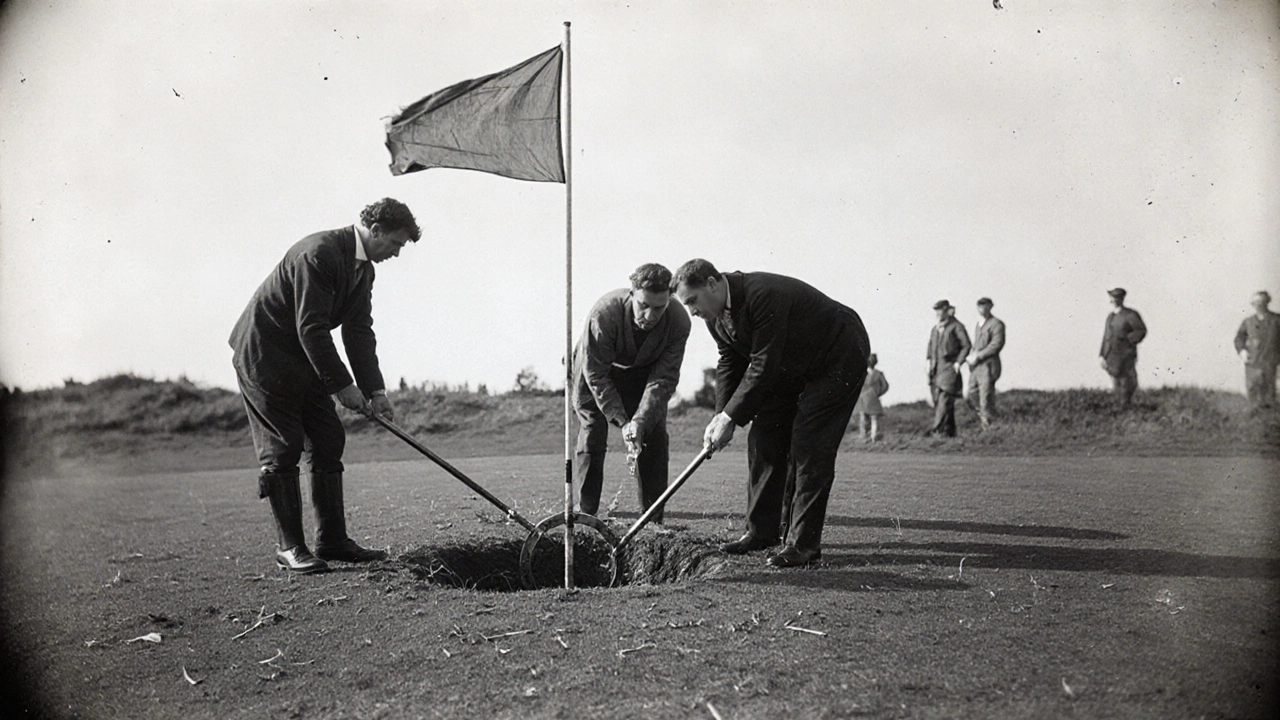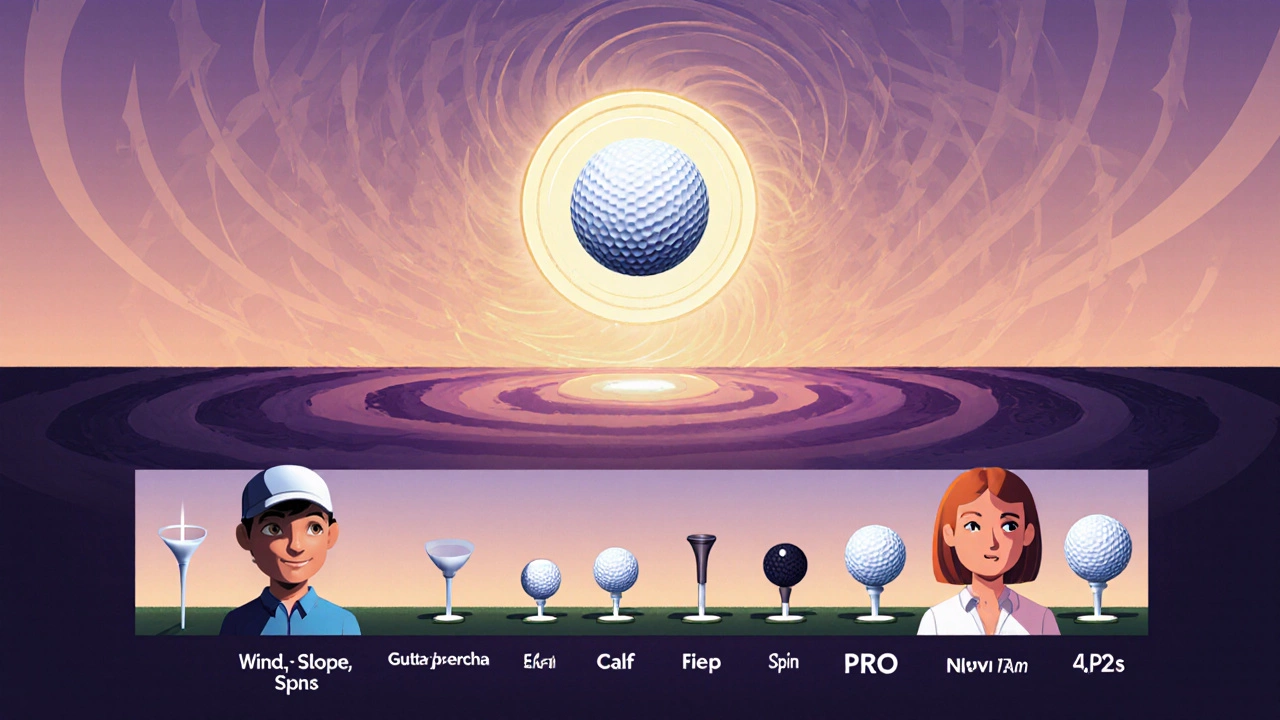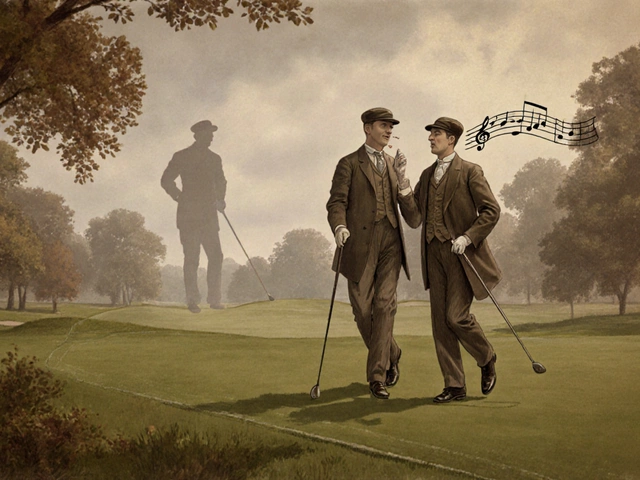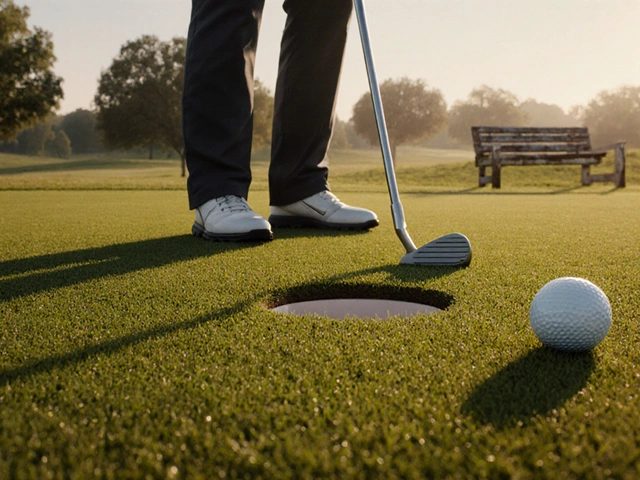Golf Putting Precision Calculator
Input Your Dimensions
Precision Required
This represents the 16.0% of the hole that the ball must occupy to fit through
Ratio: 2.50 times smaller than the hole
Why This Matters
The golf ball's 1.68-inch diameter relative to the 4.25-inch hole creates a precise 2.5x ratio. This is the Goldilocks zone: too big and putting becomes luck-based; too small and balls get stuck. Like a basketball hoop (18-inch rim), the golf hole size demands skillful control of distance, line, and speed. The article explains how this small target forces golfers to develop patience and precision—core skills that define the game.
Have you ever stood on the green, putter in hand, and thought: why is the golf hole so small? It’s barely bigger than a soda can. You’re 15 feet away, the wind is whispering, the slope is tricky-and that little 4.25-inch cup looks like a needle in a haystack. It’s not just you. Everyone wonders this. But the answer isn’t about difficulty. It’s about history, physics, and a 270-year-old decision that stuck.
The Origin: A 1754 Rule That Changed Golf Forever
The golf hole wasn’t always this size. In the 1700s, golfers in Scotland used whatever hole they could dig-sometimes as wide as 8 inches, sometimes narrower. No standard. No consistency. That changed in 1754 at the Royal and Ancient Golf Club of St Andrews. The club decided to standardize the hole using a tool called a ‘hole-cutter’-a pipe with a 4.25-inch internal diameter. Why that number? Because it was the size of the cutting tool they already had on hand. It wasn’t science. It was convenience.
But here’s the twist: it worked. The 4.25-inch size turned out to be the Goldilocks zone. Big enough for a golf ball to drop in without getting stuck, small enough to demand precision. By 1891, the Royal and Ancient officially adopted it as the rule. And by 1930, the USGA followed. Today, every hole on every course from Pebble Beach to Mumbai’s own Bombay Golf Club uses the same size. No exceptions.
Why Not Make It Bigger? The Physics of Precision
If you’re trying to sink a putt, a bigger hole sounds easier. So why hasn’t golf gone that route? Because golf isn’t just about getting the ball in. It’s about controlling distance, reading the green, and mastering touch. A larger hole would turn putting into a game of luck. The small size forces you to learn how the ball rolls, how the grain affects speed, how a slight mis-hit still finds the cup if you’ve read the break right.
Think of it like a basketball hoop. If the rim were 3 feet wide, anyone could shoot. But it’s 18 inches-just wide enough to require skill. The same logic applies to golf. A 6-inch hole would cut the number of three-putts by half. But it would also remove the art. The small hole turns putting into a mental game. It’s why a 5-foot putt can feel harder than a 150-yard iron shot.
The Ball and the Cup: A Perfect Match
The golf ball’s diameter is 1.68 inches. The hole is 4.25 inches. That’s exactly 2.5 times wider. That ratio isn’t accidental. It’s engineered. A ball that’s too close in size to the hole would get hung up on the edges. Too wide, and the ball would drop too easily-even on badly struck putts.
Modern golf balls have dimples, spin, and aerodynamic designs. But the hole hasn’t changed because it doesn’t need to. The 4.25-inch cup works with every ball ever made-from the gutta-percha balls of the 1800s to today’s multi-layered tour models. It’s a rare example of a design that aged perfectly.

What Happens If You Try to Change It?
People have tried. In 2013, the PGA Tour experimented with a larger hole-6 inches-for a charity event called ‘The Big Break.’ The result? Putts dropped like rain. Players loved the speed. Spectators loved the drama. But the pros? They hated it. They said it removed the challenge. The leaderboard looked like a lottery. The event was fun, but it proved one thing: the small hole isn’t a flaw. It’s the soul of the game.
Even the USGA has tested bigger holes in junior programs. They found that kids improved faster with larger cups-but once they moved to regulation courses, they struggled. The small hole builds a skill set that doesn’t translate to bigger targets. It’s like learning to play piano on a keyboard with narrow keys. You develop finger control. Switch to wider keys, and you lose the precision.
The Psychological Edge: Why Small Feels Harder
There’s also the mind game. A small hole triggers something in our brains. We see it as a target that’s too small to hit. That creates tension. That’s why amateurs three-putt from 5 feet. It’s not their stroke-it’s their perception. Pros don’t see a tiny cup. They see a zone. They know the ball’s path, the break, the speed. The size doesn’t scare them. It focuses them.
That’s why top players practice with smaller targets. Some use coins. Others use tees. They’re training their eyes and hands to hit a target smaller than the hole. That’s the secret: the hole isn’t the challenge. Your mind is.

What About the Cup Liner? Does It Matter?
You’ve probably noticed the plastic or metal liner inside the hole. That’s not just for looks. It keeps the grass from growing into the cup, which would make the ball bounce or roll oddly. It also ensures the hole stays exactly 4.25 inches. Without the liner, the hole could shrink or expand with weather, soil, or wear. The liner is the unsung hero keeping the rule alive.
And yes, the liner is removable. That’s why you sometimes see holes with slightly different depths or edges. But the diameter? Always 4.25 inches. That’s non-negotiable under Rule 16.1b of the Rules of Golf.
Could It Ever Change?
Probably not. The R&A and USGA are traditionalists. They don’t change rules unless there’s overwhelming evidence. And there isn’t any. Golfers want challenge. They want history. They want the same hole that Bobby Jones faced in 1930. The small cup is part of golf’s identity. It’s why the game feels different from every other sport. It’s not about power. It’s about patience. About control. About quiet precision.
Imagine if basketball changed the rim size every decade. Or if tennis changed the net height. Golf doesn’t do that. It holds on to its roots. And the small hole? It’s the most visible symbol of that.
What You Can Do About It
If you’re frustrated by the small hole, don’t blame the design. Change your approach. Practice putting with a coin on the green. Try to sink 10 in a row. Play a round where you can only use your putter. Learn to read the green like a map. The hole isn’t the problem. Your confidence is.
And next time you stand over a 6-footer, remember: you’re not trying to hit a tiny cup. You’re trying to control a ball on a moving surface. The hole is just the finish line. The real game happens before you swing.
Why is the golf hole exactly 4.25 inches?
The 4.25-inch size comes from a hole-cutter used by the Royal and Ancient Golf Club of St Andrews in 1754. It was the tool they had on hand, and it worked well enough to become the standard. No deep science-just practical history that stuck because it balanced playability and challenge.
Has the golf hole ever been larger?
Yes, before 1754, holes varied widely-from 3 inches to over 8 inches. Even after standardization, some courses used larger holes into the early 1900s. But by the 1930s, the 4.25-inch size was universal under official rules.
Do professional golfers prefer the small hole?
Absolutely. While they can sink putts from 20 feet, they say the small hole is what makes putting a true skill. A larger hole would reduce the need for touch, line reading, and speed control-three things that separate pros from amateurs.
Is there a minimum depth for a golf hole?
Yes. Rule 16.1b requires the hole to be at least 4 inches deep. This ensures the ball doesn’t bounce out. Most courses dig them 6 inches deep to prevent interference from grass or soil.
Can I use a bigger hole on my home green?
You can, but it won’t help your game. If you practice on a larger hole, you’ll lose the feel for precision needed on real courses. For real improvement, stick to regulation size-even at home.
So next time you stand over a short putt and think the hole’s too small, remember: it’s not a design flaw. It’s a tradition. A test. A quiet challenge that’s been part of golf for nearly three centuries. And it’s still working just fine.





